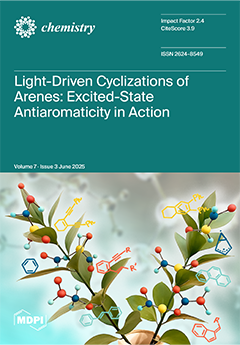A ligand exchange reaction between [Ru
2(npc)
2(O
2CMe)
2] (
1; npc = 1,8-naphthyridine-2-carboxylate) and trifluoroacetic acid yielded the diruthenium naphthyridine complex with two trifluoroacetate ligands, [Ru
2(npc)
2(O
2CCF
3)
2]
[...] Read more.
A ligand exchange reaction between [Ru
2(npc)
2(O
2CMe)
2] (
1; npc = 1,8-naphthyridine-2-carboxylate) and trifluoroacetic acid yielded the diruthenium naphthyridine complex with two trifluoroacetate ligands, [Ru
2(npc)
2(O
2CCF
3)
2] (
2), which was structurally characterized by electrospray ionization mass spectrometry, elemental analysis, infrared spectrum, and synchrotron single-crystal X-ray diffraction. The crystal structure of
2 adopts a paddlewheel-type structure in which two npc and two O
2CCF
3 ligands are coordinated in a
cis-2:2 arrangement around the Ru
2 core. The temperature-dependent magnetic susceptibility measurements indicated that
2 has (i) an
S = 1 spin state for the Ru
24+ core and (ii) a large
D value of 243 cm
−1; characteristic of paddlewheel-type Ru
2 complexes. The cyclic voltammetry measurements indicated that
2 exhibited one reversible oxidation wave (E
1/2 = 0.72 V vs. SCE) and two reduction waves (E
1/2 = −0.67 and −1.10 V vs. SCE); which were clearly positively shifted when compared with those of
1. Additionally, the absorption spectrum of
2 displayed intense absorption bands in the visible region; attributed to metal-to-ligand charge transfer from the Ru
2 core to the npc ligands; which were blue-shifted by approximately 70–100 nm when compared with those of
1. These distinct shifts in redox potentials and absorption bands originated from the strong electron-withdrawing effect of the O
2CCF
3 ligands in
2.
Full article





